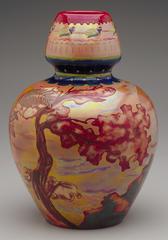
 |
 Hungary was a society based on small family farms and goods produced locally well into the nineteenth century. The end of the century, however, saw an economic boom that brought with it advances in the arts, technology, and sciences. In 1896, the Millennial celebrations created interest in native Hungarian traditions.
Hungary was a society based on small family farms and goods produced locally well into the nineteenth century. The end of the century, however, saw an economic boom that brought with it advances in the arts, technology, and sciences. In 1896, the Millennial celebrations created interest in native Hungarian traditions.
Miklos Zsolnay founded a small ceramics workshop in 1851 in Pécs, in southern Hungary, producing simple, useful wares that were sold to local people. When his son Vilmos, a skilled designer and entrepreneur, took over in 1865, he added a new range of decorative vessels, some with designs based on traditional peasant embroidery. This vase, made about 1906, displays the vivid luster glazes that won the factory international renown. Under Vilmos's leadership, the Zsolnay Ceramics Factory was able to join in the economic boom. The factory grew into a modern industry that exported 80 percent of its wares to other countries.
Key ideas.
Where does it come from?
What does it look like?
How was it used?
How was it made?
How big is it?
Who Knows?
Additional resources.
